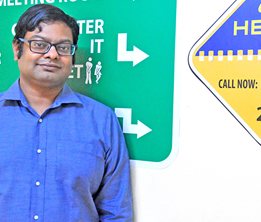Name : Anirban Chakraborti
Position : CEO of Hello Cabs
Anirban Chakraborti is currently the Chief Executive Officer (CEO) of Hello Cabs taxi services in Myanmar. With over 12 years of experience in technology, infrastructure, and service industries spanning US, Europe and Asia, Chakraborti has also been an entrepreneur in data analytics. He was previously the Board Representative and CEO Advisor at Hello Cabs before being promoted to the CEO position recently. Myanmar Insider met with him to talk about the company and the services.
Tell us about Hello Cabs. What is your mission and when did you start operating?
We started operating on August 6, 2015.
Unlike other developed markets that I’ve been involved with and as opposed to other developing countries, [Myanmar does] not have quality, standardized product in transportation, especially in a personal transportation. You have a lot of cabs but the quality is anything but good. Although the cab drivers will charge you the same fare to get from point A to point B, the quality of one cab might be much better than another. So what we figure out is there is an opportunity in the market to put a quality, standardized product which people can use. Whenever they use it, they know they’re getting something good which isn’t same as the previous experiences. But there are two big challenges in the country when we started. One was people here are not used to using meters, everything was done by bargaining. The second challenge was people were not used to taking taxis on their own call. There is no way to call for a taxi. They usually go to the corner and take the taxi. So these were two big mindset change challenges which we have to tackle. We’ve been successful to some extent in getting people using meters and getting people to call us for a cab, to get a quality cab in their doorsteps. Now in any part of Yangon we can give you a cab within ten minutes of calling, which is the same time to take a cab from a curb.
In Myanmar, where do you operate?
We currently mainly operate in Yangon. We have some operations, very little operations in Naypyidaw and Mandalay as well. Because Yangon is the biggest commercial city, our focus is here to capture the market.
How many cabs or cars do you have?
Right now we have over 500 cabs or cars running in the city.
How do you hire drivers? How about the qualifications for the potential drivers?
We have a very stringent process. We ensure the cars meet certain criteria in engine power, air conditioning, seats properly maintained, and making sure its registered with the local authorities. That is from the car point of view. The drivers sign a contract saying they are going to follow our rules and regulations. We also insist on of two different background checks, one from the police station and one from the neighborhood where they’re living to ensure they are of good character. Only after all of these checks are cleared, the car is able to pick up passengers
What incentives do you give them to join you rather than work independently?
We do not give them a monetary incentive. Now we have steady customers. Every day, we do thousands of trips. Out of these thousand of trips, 80 percent to 90 percent customers are repeat customers. Everyday 10 to 15 percent are new customers. The drivers, if they are working with us, there is a high predictability that they will definitely get jobs. Especially like in rainy seasons, we have a lot of rain so you find no cab on the road, but we are always there. So in rainy seasons, they make a lot of money with us. People still need cabs when it’s raining so they call us and our business grow exponentially high during the rainy season.
There are so many taxis in Yangon already. What made you decide to start a taxi company?
There are so many taxis in Yangon but it is not standardized. If you go to any developing country’s capital, you see the cabs are standardized. They’re good quality, they use meters. You can see that in most of the countries in the world now. But here in Yangon, the quality of one cab to another is very different. And the fare is the same. What we want is we would like to give our customers same amount of predictability like in other countries. They can take comfort in the fact that if they use a Hello cab, they are getting a standardized service, a safe service,and they know the driver will be polite and the air conditioning will work so they know they will get a comfortable service. Our motto is ‘customer service first’. And we have a consistent service. Whether you book a Hello Cab now or in the middle of the night or on a rainy day, you will get the same quality service. That is our focus.. The challenge is to maintain the high quality of service 24/7 and 365 days a year.
How do you ensure the drivers are able to pick up the customers in a timely manner? It seems like in many cases it could be quicker for customers to hail a cab off the street.
If a customer wants a cab, he still has to walk down to the curb and wait for it. That process takes five to seven minutes. Before you start walking, you just call a cab and say you want a cab at this location. Because we have a huge number of cars using new technology, we can quickly dispatch the nearest car to you within five to seven minutes. You can only provide high quality service when you have very high quality technology. We have invested a lot of money in technology and also people who use the technology. We train the drivers regularly on using the apps which help them get to the customer quickly, we train the call center operators on how to give the correct coordinates of the customers to the driver. Our taxis’ dispatch system tracks the car to ensure it reach the right destination.
Do you have specific mechanisms for training your drivers?
We do have a module. It’s a half day training which is given by our operations team, where the call center persons, the operation persons and the technology person’s, everybody in the process explains in details how our systems works and what is expected from the drivers and what is expected from us.
You advertise that clients can order a taxi to be serviced to their door by using a mobile app. Can you tell us how this works?
The mobile application can pick your location when you book a cab and send it to our taxi dispatch system. The system finds a nearest cab and sends back a notification to the mobile application saying this is the car number, this is the driver number and this cab will come and pick you. So you can wait for the cab to come or you can contact the driver because you already got the driver’snumber. So it is a very interactive system where the customer knows where the driver is in each step. So you will see a comfort that somebody is there to help you out.
How do you charge using a Hello Cab? Please explain your metering system.
We have a metering system based on GPS. Worldwide, there are two different metering systems, one is the digital system connecting to the wheels which is an expensive system. The other one is using GPS which is much more accurate. We have a base fare, called a flag-down fare. We also have a certain charge for the riding time. We’ve done a lot of study in terms of understanding why a taxi charges a thousand kyat from point A to point B. And we’ve worked that back into our metering system.
It is the same for everyone. If you take an off-call job, the basic fare is fifteen hundred kyats for two kilometers. And if you take an on-call job, the basic fare is two thousand kyats for three kilometers. It is the same for everyone.
Do you find that customers trust automated payment systems in this country?
Yes, automated payment system will be the future. Because carrying big notes will increasingly be frustrating. We’re also moving towards the automated payment system where you’ll be able to make digital payment using any company directly to Hello Cabs and the driver will get notified. We’re in the process of building the technology ourselves.
Do you anticipate Uber which had trouble claiming a market share in China entering the Myanmar market?
When Uber was in China, it was not number one, Didi was, Uber was number two. Now the two have merged and Uber China is gone. Similarly in India, there is Ola and Uber. Uber is number two in India. Ola, the local player, is number one. Let’s talk about Indonesia or Malaysia, you see the Grab Taxi is number one, Uber is number two. Uber is number one in European markets. So in the local Southeast Asian markets, there is always place for two players. The local player is always number one. Will Uber come to the Myanmar market? They will. But are they going to do it anytime for soon? I have a doubt because they are an IPO right now. So yes they will come to the Myanmar market and either compete with us or join us.
If Uber comes here, how will you distinguish yourself from this western company?
First of all, we are a local company, a fully local company. Secondly, we do not work on the Uber technology or model. Uber technology or model typically is only app-based on credit card payments. We operate on cash model. We operate on open-meter system, so when you get in a cab, you see the meter ticking. Uber is only an app, you do not see the meter ticking. You know there is a meter. So there are great thing that distinguishes us because our system will be for the local market. So there is a great deal of difference in terms of how the two players operate.
How about the competition from other local companies?
To be honest, we have seen a lot of competition from other local companies for the last one year. But I have not seen any sustainable competition. The game here is not so much about having an app or technology, the game here is how can you operate day in and day out 24/7, 365 days the same way. If you’re operating differently in morning or night, the customers will find that difference of service. And it takes a lot of money and effort to ensure that 24/7, 365 same level of service. That experience takes time. There is no shortcut to it. Even the company like Uber in the first two years had to learn that. Even in a new market Uber has to learn that the first year. They have to learn how the local market operates, how the drivers operate, how the traffic is. They need to learn how to solve local issues. Our biggest advantage is we have a lot of data. We have gathered a lot of data for the past one year. We use artificial intelligence or machine learning which is very effective way to understand what our customer needs and where we have to put the effort into our marketing. That helps us to very focus and specialize marketing. Other companies do not have this data, it takes time to learn to use the technology and to gather the data.
What will be the next destinations of your service?
Other than Naypyidaw and Mandalay, we’ll take our cabs outside of Yangon like Bago and other cities such as Taunggyi, Bagan and Dawei. We will definitely open in these cities. We are ready to roll out.










